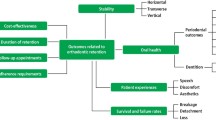Abstract
Data sources
Medline via OVID, PubMed, Cochrane Central Register of Controlled Trials, Web of Science Core Collection, LILACS and BBO databases. Unpublished clinical trials accessed using ClinicalTrials.gov, National Research Register, ProQuest Dissertation and Thesis database.
Study selection
Two authors searched studies from inception until May 2016 without language restrictions. Quantitative and qualitative studies incorporating objective data on compliance with removable appliances, barriers to appliance wear compliance, and interventions to improve compliance were included.
Data extraction and synthesis
Quality of research was assessed using the Cochrane Collaboration's risk of bias tool, the risk of bias in non-randomised studies of interventions (ROBINS-I), and the mixed methods appraisal tool. Statistical heterogeneity was investigated by examining a graphic display of the estimated compliance levels in conjunction with 95% confidence intervals and quantified using the I-squared statistic. A weighted estimate of objective compliance levels for different appliances in relation to stipulated wear and self-reported levels was also calculated. Risk of publication bias was assessed using funnel plots. Meta-regression was undertaken to assess the relative effects of appliance type on compliance levels.
Results
Twenty-four studies met the inclusion criteria. Of these, 11 were included in the quantitative synthesis. The mean duration of objectively measured wear was considerably lower than stipulated wear time amongst all appliances. Headgear had the greatest discrepancy (5.81 hours, 95% confidence interval, 4.98, 6.64). Self-reported wear time was consistently higher than objectively measured wear time amongst all appliances. Headgear had the greatest discrepancy (5.02 hours, 95% confidence interval, 3.64, 6.40). Two studies found an increase in compliance with headgear and Hawley retainers when patients were aware of monitoring. Five studies found younger age groups to be more compliant than older groups. Three studies also found compliance to be better in the early stages of treatment. Integration between quantitative and qualitative studies was not possible.
Conclusions
Compliance with removable orthodontic appliances is suboptimal. Patients wear appliances for considerably less time than stipulated and self-reported. Compliance may be increased when patients are aware of monitoring; however, further research is required to identify effective interventions and possible barriers in order to improve removable orthodontic appliance compliance.
Similar content being viewed by others
Commentary
The success of orthodontic treatment using removable appliances relies upon many factors, but key is patient compliance, as failure to wear the devices will result in lack of movement and relapse.1, 2, 3 Various techniques have been suggested which aim to improve compliance, such as headgear calendars and conscious hypnosis,4, 5 although high quality research is still required to investigate other methods and their effectiveness.6
The systematic review's primary aim was to assess levels of compliance with various removable orthodontic appliances and adjuncts. This involved assessing the discrepancy between actual wear, self-reported wear, and stipulated wear. Secondary aims were to assess the effectiveness of interventions used to improve compliance levels, to explore patient experiences and interventions, to enhance compliance with removable adjuncts and to identify factors affecting cooperation.
Several databases were searched for quantitative and qualitative studies with no limits placed on language. Of the 24 included studies, two were randomised controlled trials, 21 were prospective cohort studies and one had a mixed-methods design. Data extraction was carried out rigorously and included numerous categories such as: 1) appliance used, 2) stipulated wear times, 3) objective wear times, 4) self-reported wear times and 5) factors influencing compliance levels.
In addition, quality assessment was also carried out. Multiple methods were used to assess the risk of bias of included studies: the Cochrane Collaboration's risk of bias tool was used to assess the quality of randomised controlled trials, the risk of bias in non-randomised studies of interventions tool (ROBINS-I) was used to assess non-randomised studies and the mixed methods appraisal tool was used to assess the quality of mixed methods studies. Unfortunately, quantitative and qualitative data could not be integrated as thematic synthesis was not possible.
Multiple conclusions may be drawn from the review. Compliance is not directly related to the type of appliance, and there was no statistically significant difference between intra-oral and extra-oral appliances. Patients are likely to self-report wear time at approximately five hours more than the actual wear time and approximately three hours more than the stipulated wear time each day. In two studies, a slight increase in compliance with headgear and Hawley retainers was seen when the patient was aware of monitoring.7, 8 Furthermore, the use of headgear calendars4 and conscious hypnosis5 were shown to increase the duration of headgear wear. Three studies showed that girls are more compliant than boys,9, 10, 11 and in five studies, patients in younger age groups are more compliant than those in older age groups.4, 8, 10, 11, 12 Lastly, in three studies, compliance was shown to decrease as treatment progressed.10, 12, 13
The authors of the review are forthcoming with their limitations. Both randomised and non-randomised controlled studies were included. Clearly, non-randomised studies have a greater inherent risk of bias14 and the majority of included papers were cohort studies which have an even larger risk of bias. However, inclusion was appropriate as discrepancies between self-reported and observed wear were being sought. Over a third of the included studies suffered from a high risk of bias. Additionally, the follow-up period in all included studies did not exceed six months. This is particularly important when considering relapse due to compliance after active orthodontic treatment.
In summary, this review was well conducted. However, there is a need for prospective research evaluating the effectiveness of interventions aimed at improving compliance with removable orthodontic appliances.
Practice point
-
Compliance with all types of removable orthodontic appliances is suboptimal, with the actual wear time being approximately five hours less than stipulated per day. This may be improved if patients are aware that they are being monitored
-
There is no statistically significant difference in patient compliance when using either intra-oral or extra-oral orthodontic appliances. Younger patients and those in the earlier stages of treatment are more likely to be compliant.
References
Miethke RR, Wronski C . What can be achieved with removable orthodontic appliances? J Orofac Orthop 2009; 70: 185–199.
Pratt MC, Kluemper GT, Lindstrom AF . Patient compliance with orthodontic retainers in the postretention phase. Am J Orthod Dentofacial Orthop 2011; 140: 196–201.
Skidmore KJ, Brook KJ, Thomson WM, Harding WJ . Factors influencing treatment time in orthodontic patients. Am J Orthod Dentofacial Orthop 2006; 129: 230–238.
Cureton SL, Regennitter FJ, Yancey JM . The role of the headgear calendar in headgear compliance. Am J Orthod Dentofacial Orthop 1993; 104: 387–394.
Trakyali G, Sayinsu K, Muezzinoglu AE, Arun T . Conscious hypnosis as a method for patient motivation in cervical headgear wear—a pilot study. Eur J Orthod 2008; 30: 147–152.
Aljabaa A, McDonald F, Newton JT . A systematic review of randomized controlled trials of interventions to improve adherence among orthodontic patients aged 12 to 18. Angle Orthod 2015; 85: 305–313.
Hyun P, Preston CB, Al-Jewair TS, Park-Hyun E, Tabbaa S . Patient compliance with Hawley retainers fitted with the SMART((R)) sensor: a prospective clinical pilot study. Angle Orthod 2015; 85: 263–269.
Brandão M, Pinho HS, Urias D . Clinical and quantitative assessment of headgearcompliance: a pilot study. Am J Orthod Dentofacial Orthop 2006; 129: 239–244.
Clemmer EJ, Hayes EW . Patient cooperation in wearing orthodontic headgear. Am J Orthod 1979; 75: 517–524.
Sahm G, Bartsch A, Witt E . Reliability of patient reports on compliance. Eur J Orthod 1990; 12: 438–446.
Schäfer K, Ludwig B, Meyer-Gutknecht H, Schott TC . Quantifying patient adherence during active orthodontic treatment with removable appliances using microelectronic wear-time documentation. Eur J Orthod 2015; 37: 73–80.
Bos A, Kleverlaan CJ, Hoogstraten J, Prahl-Andersen B, Kuitert R . Comparing subjective and objective measures of headgear compliance. Am J Orthod Dentofacial Orthop 2007; 132: 801–805.
Bartsch A, Witt E, Sahm G, Schneider S . Correlates of objective patient compliance with removable appliance wear. Am J Orthod Dentofacial Orthop 1993; 104: 378–386.
Horowitz SL, Hixon EH . Physiologic recovery following orthodontic treatment. Am J Orthod Dentofacial Orthop 1969; 55: 1–4.
Author information
Authors and Affiliations
Additional information
Address for correspondence: Dalya Al-Moghrabi, Centre for Oral Growth and Development, Barts and the London School of Medicine and Dentistry, Queen Mary University of London, London E1 2AD, United Kingdom. E-mail: dalya_h_m@hotmail.com.
Al-Moghrabi D, Salazar FC, Pandis N, Fleming PS. Compliance with removable orthodontic appliances and adjuncts: A systematic review and meta-analysis. Am J Orthod Dentofacial Orthop 2017; 152: 17–32. doi: 10.1016/j.ajodo.2017.03.019. Review. PubMed PMID: 28651764
Rights and permissions
About this article
Cite this article
Shah, N. Compliance with removable orthodontic appliances. Evid Based Dent 18, 105–106 (2017). https://doi.org/10.1038/sj.ebd.6401268
Published:
Issue Date:
DOI: https://doi.org/10.1038/sj.ebd.6401268



